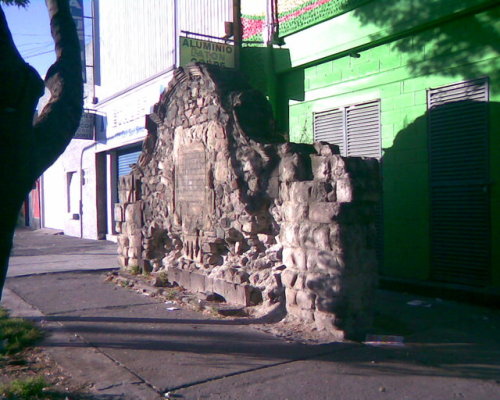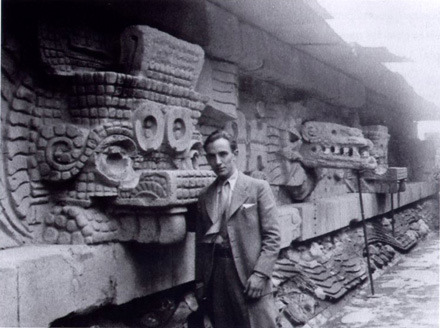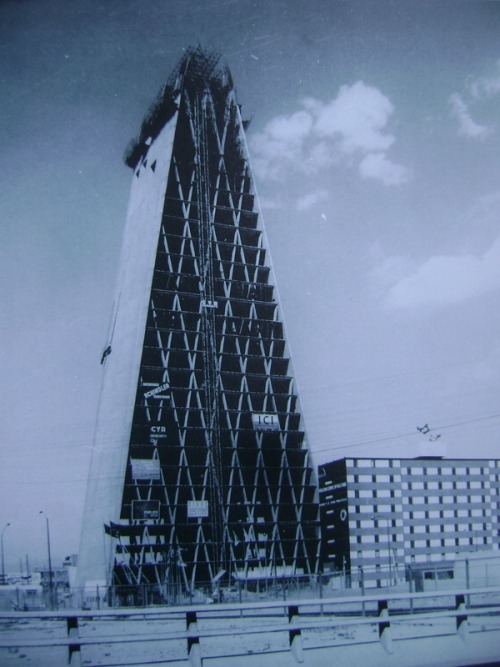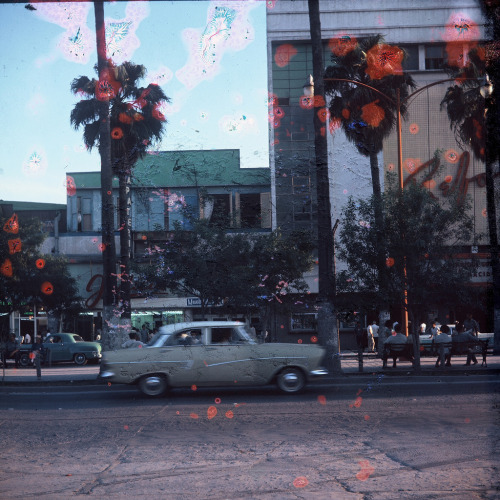12.16.2010
10.15.2010
9.12.2010
flight of the calder

The latest one features a series of before and afters of the Mexico City Camino Real Hotel (1968), detailing the tragic refitting of the interiors in NAFTA moderne style (paradoxically, by the original architect, Ricardo Legorreta, no less).
It's particularly disheartening to see a once stark and dramatic lobby that was presided over by an electric-orange spider-like Calder turned into a tacky snack bar.
Pablo reports that the sculpture was eventually auctioned at Christie's and sold to some Portuguese fellow with better taste and sense of historical and aesthetic merit than the sad lot of Mexican barons that now handle the hotel.
So goes modernity in Mexico.
Labels:
1968,
apogee,
calder,
decline,
modernization,
pabloleondelabarra
9.07.2010
fiberglass ambassadors
Je ne passe jamais devant un fétiche de bois, un Boudha doré, une idole mexicaine sans me dire: C'est peut-être le vrai dieu.
Labels:
baudelaire,
benjamin,
mexicanness,
modernism
9.02.2010
8.28.2010
8.24.2010
8.07.2010
8.01.2010
7.22.2010
6.10.2010
5.27.2010
oh-woh baby
I was unaware of the African-American Female Singing Norteño Covers on Youtube sub-genre.
5.24.2010
5.20.2010
authoritarian representation

Architecture as authoritarian representation.
Labels:
apogee,
architecture,
decline,
politics,
space,
tlatelolco
5.19.2010
5.13.2010
4.09.2010
1965
Luis Buñuel, Simon of the Desert. (1965)
More on The Desert, faith, technology, consumerism, gadgetry and endless-loop mutually dependent negative relationships:
Sam Jacob, "More Scenes in Cartoon Deserta". (2009)
Reyner Banham, "The Great Gizmo". (1965)
Footnote 1. Consider that while gadgets might fail consumer capitalism hasn't. Gadgets aren't only delivered everywhere anywhere: they are the means of delivering consumer culture, everywhere anywhere. The magical-mechanical coffin is only the medium.
Footnote 2. Modern Consumerist Cities as the ultimate Desert.
Footnote 3. Buñuel takes the fall of Simon as the fall of Heroic Modernisms. (Vid. Spain under Franco or Post-Revolutionary Mexico.) Consumer culture was the final nail on the coffin for Revolution. The calm of consumer culture conquers the scary wilderness of sociopolitical disruption.
#lgnlgn
Labels:
1968,
banham,
buñuel,
decline,
films,
lgnlgn,
politics,
pop,
religion,
revolution,
silviapinal,
technology
3.07.2010
rocky

By the 1940s the expansion of the city made this relatively flat -- albeit very rocky -- area of interest to speculators, among whom was the architect and landscape gardner Luis Barragán...
(Whoa. First time I see someone refering to Barragán as a "speculator".)(Which makes him even more representative of Mexican modernist architecture.)
3.02.2010
2.25.2010
2.13.2010
2.08.2010
1.31.2010
there is more to modernist architecture in mexico than barragán
Labels:
apogee,
architecture,
exhibitions,
josecastillo,
mexicanness,
modernism,
space
1.25.2010
taxi!

One of the things that really made me depressed when I was back in Mexico City for Christmas was the new designated color code for taxi cabs. Who came up with the hideous burgundy-gold combo? And what's with the gay Angel de la Independencia logo stenciled on the side?
greatest show on earth
Labels:
1994,
decline,
mexicanness,
modernization,
neodesarrollismo,
politics,
pop,
salinas,
solidaridad,
space,
televisa
1.20.2010
estrellita

The "Estrella Pronaf" building (Pronaf Star) in Piedras Negras, Coahuila --the main building of the local Pronaf and Puerta de México site, designed by Mario Pani and built in the early 1960s-- is slated to be demolished this month.
According to a local architect who is apparently in charge of a new redevelopment program in the area, the building doesn't correspond to the current "modern image" the city wants to project, and that through the demolition of the Pronaf and the inauguration of a new "Paseo del Río" riverwalk, the city will "automatically recover the tourism it has lost." (Uhm, yeah, I'm sure the problem was the Pronaf complex, not the narcoviolence or anything of the sort).
It's kind of ironic that this guy is using the exact same excuse the Pronaf did in its day, of "creating first-class, family-oriented, healthy tourist attractions" to counter the current trend of crossborder bar-hopping.
Again, Mexico proves it gives a rat's ass about its Modern heritage.
Labels:
border,
decay,
mariopani,
modernism,
piedrasnegras,
preservation,
pronaf
Subscribe to:
Comments (Atom)





























.jpeg)
